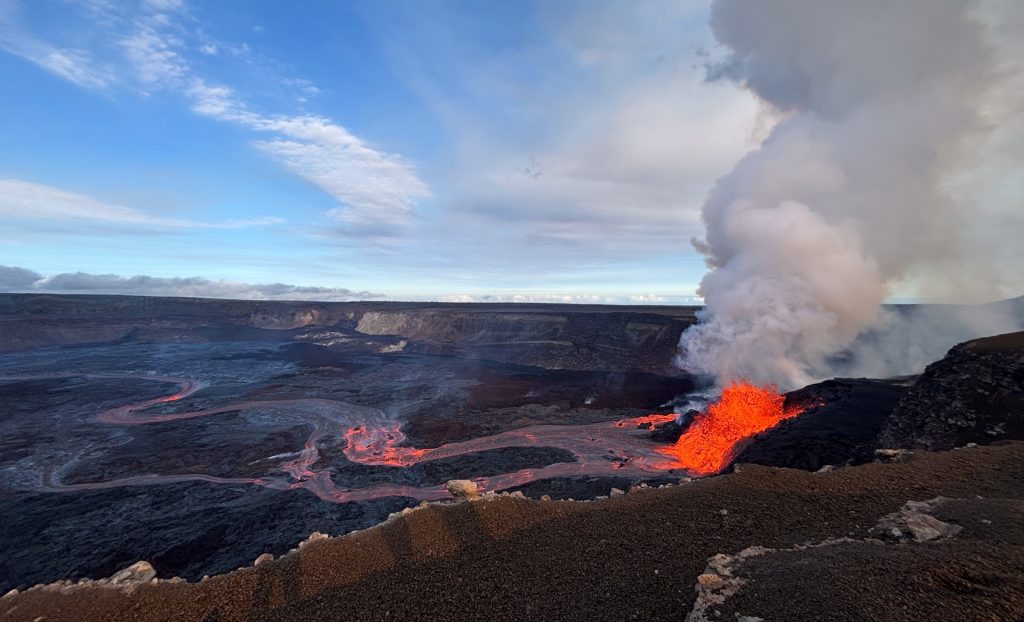Volcano Watch: Ancient volcanoes are critical to our modern world
“Volcano Watch” is a weekly article and volcano activity update written by scientists and affiliates with U.S. Geological Survey Hawaiian Volcano Observatory on the Big Island.
If you’ve read “Volcano Watch” articles before, you can probably list several reasons scientists study volcanoes. However, there is a reason that might surprise you: critical mineral resources of economic importance.
Volcanoes act as windows deep into Earth. They help us understand the formation of our planet and the others in our solar system.
Living on or near an active volcano can be beneficial because of their rich soils and tourism appeal, but also pose hazards to the communities around them.
For this reason, we need to understand what drives volcanic eruptions and monitor volcanoes to keep communities safe.
Long after magma has stopped rising through the crust and the last eruption at a volcano ceases, another process takes places in volcanic systems deep underground.

Fluids begin to percolate through the system — they flow through the old magma reservoirs, the dykes and sills, buried lava flows and hydrothermal systems — transporting elements and chemically altering the surrounding rocks.
Unlike the geologically short and violent lives of volcanoes, the formation of mineral systems is a slow, quiet process that can take millions of years.
According to the Energy Act of 2020, “critical minerals” are those minerals, elements, substances or materials that serve an essential function for energy technology with high risk of supply chain disruption, including elements such as lithium, nickel, magnesium, platinum, iridium and rare earth elements, among others.
These elements have become important for our everyday lives, used in everything from solar panels, batteries and vehicles to power plants, medical devices and smartphones.
More than half of the world’s critical mineral resources formed in ancient volcanic systems.
When exploring for mineral resources, your location within the volcanic system will determine the type of ore bodies you’d expect to find.
For instance, deep in the volcanic system, minerals such as chromium, titanium, vanadium and platinum-group elements are found in layered intrusive rocks that were once bodies of magma that never made it to the surface.
The most abundant source of rare earth elements are strange magmas called carbonatites found at the edges of ancient continents and in ancient rift systems within continents.
In other volcanic systems, such as submarine volcanoes, magmatic-hydrothermal systems yield minerals such as copper, lead, zinc and gold.
The richest mineral deposits are often found in the oldest volcanic rocks. They’ve been weathered down, eroded and buried, while fluids have moved through continuously altering the rocks themselves.
You probably wouldn’t recognize them as old volcanic systems without a geology degree — and even then, it’s hard!
As geologists, we use observations of our modern world to help us understand the formations of the past.
Studying recent and active volcanic systems — where they form, how they’re shaped inside, what magmas they produce and how they interact with the surrounding environment — allows us to better understand and explore for these ancient, mineral-bearing systems that power the modern and future world.
So next time you visit a national park with volcanoes such as Kīlauea or Yellowstone, imagine hiking on what could be a future ore deposit millions of years from now.
VOLCANO ACTIVITY UPDATES
KĪLAUEA
U.S. Geological Survey Volcano Alert Level: WATCH

Kīlauea on the Big Island has been erupting episodically in Halemaʻumaʻu Crater within its summit caldera since Dec. 23, 2024. All eruptive activity has been and is confined inside Hawai‘i Volcanoes National Park.
Episode 29 of the summit eruption — the most recent eruptive activity in the series — included about 13 hours of lava fountaining July 20, predominantly from the north vent.
Sulfur dioxide emission rates are elevated in the summit region during active eruption episodes.
No unusual activity has been noted along Kīlauea’s East Rift Zone or Southwest Rift Zone.
WHAT’S NEXT?: Summit region inflation since the end of Episode 29, along with persistent tremor, suggests another episode is possible and could start as early as July 31.
MAUNA LOA
U.S. Geological Survey Volcano Alert Level: NORMAL
Mauna Loa on the Big Island is not erupting.
Hawaiian Volcano Observatory continues to closely monitor Kīlauea and Mauna Loa.
EARTHQUAKE REPORT
One earthquake was reported felt in the Hawaiian Islands during the past week:
- MAGNITUDE-3.1 located a short distance south of Kealakekua on the west side of the Big Island at a depth of 5 miles at 9:07 p.m. July 21.
Visit the Hawaiian Volcano Observatory website for past “Volcano Watch” articles, Kīlauea and Mauna Loa updates, volcano photos, maps, recent earthquake information and more. Email questions to askHVO@usgs.gov.



